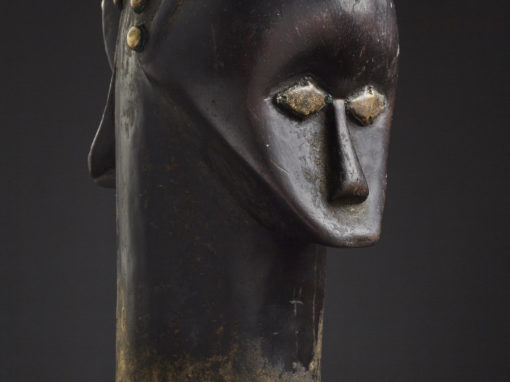
TÊTE D’ANCÊTRE or têtes de reliquaire (angokh-nlo-byeri)
origin: equatorial forest, africa, Ntem area ?
region: nord gabon, cameroon
age : XIX / XX century
object: „NLO BYERI”, fang „MVAÏ“ reliquary head (to be garding „nsek byerie“)
size / material: hight 23,5 cm / coiffure 11,0 cm wide / deep 13,0 cm / neck 6,5 cm / – wood with oil, copper nails, feathers,
This Fang MVAÏ head, reflects classic quality with a soft shinning black patina, its a fascinating example of an angokh-nlo-byeri.
The Fang, from Equatorial Africa (Southern Cameroon, Equatorial Guinea and Northern Gabon), had established cults of the ancestors, known as byeri, which lead them to create symbolic representations of the deceased in the form of wooden heads. They are called angokh-nlo-byeri. – literally “ entire head of the ancestor “ The heads remain very rare compared to the complete figures and are in general particularly well-carved. These ritual effigies were used to magically guard the ancestral human relics preserved in tall cylindrical bark boxes and each family head was either placed into or onto it.
Generation after generation, the angokh-nlo-byeri. heads stayed hidden away from the world in the lineage chief’s hut. The carved heads were periodically coated with palm oil amongst other substances.
Most of the known Fang heads today wich are more or less documented, were found among the southern Fang.
This MVAÏ head is a work of rare quality, the four eyes indicated by copper nails covered by a black patina, hypnotically glaring at any observer – a round forehead and face with a classic “heart shape”, completed with a helmet like thick coiffure completing this angokh-nlo-byeri.. The eye section reminds us of another famous Fang Nlo Byeri – the one from the Babier-Mueller Collection. They also share another important detail – the face of this MVAÏ angokh-nlo-byeri. is falling almost vertical on the nape of the neck. Most noticeable is the remaining bush of feathers emerging directly from on top of the head slightly behind another opening that still contains a possible “magic load”.
Its black satiny surface gives it a breathtaking, timeless appearance. Surely sculpted by a master-carver, a ngengang. To carve such a piece, the carver had to be initiated, not only for the use of tools, but also to be able to deal with the occult forces involved in this particular work. Carving the image of a deceased person was a ritual act in itself. As elsewhere in Africa, the notion of beauty in appearance and of goodness as moral quality, and also of social and political power, were intricately linked.
(text contains excerts from various texts by L. Perrois)







